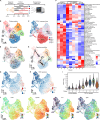TGF-β signaling redirects Sox11 gene regulatory activity to promote partial EMT and collective invasion of oncogenically transformed intestinal organoids
- PMID: 40393982
- PMCID: PMC12092639
- DOI: 10.1038/s41389-025-00560-7
TGF-β signaling redirects Sox11 gene regulatory activity to promote partial EMT and collective invasion of oncogenically transformed intestinal organoids
Abstract
Cancer cells infiltrating surrounding tissue frequently undergo partial epithelial-mesenchymal transitions (pEMT) and employ a collective mode of invasion. How these phenotypic traits are regulated and interconnected remains underexplored. Here, we used intestinal organoids with colorectal cancer (CRC) driver mutations as model system to investigate the mechanistic basis of TGF-β1-induced pEMT and collective invasion. By scRNA-seq we identified multiple cell subpopulations representing a broad pEMT spectrum, where the most advanced pEMT state correlated with the transcriptional profiles of leader cells in collective invasion and a poor prognosis mesenchymal subtype of human CRC. Bioinformatic analyses pinpointed Sox11 as a transcription factor gene whose expression peaked in the potential leader/pEMThigh cells. Immunofluorescence staining confirmed Sox11 expression in cells at the invasive front of TGF-β1-treated organoids. Loss-of-function and overexpression experiments showed that Sox11 is necessary, albeit not sufficient, for TGF-β1-induced pEMT and collective invasion. In human CRC samples, elevated SOX11 expression was associated with advanced tumor stages and worse prognosis. Unexpectedly, aside from orchestrating the organoid response to TGF-β1, Sox11 controlled expression of genes related to normal gut function and tumor suppression. Apparently, Sox11 is embedded in several distinct gene regulatory circuits, contributing to intestinal tissue homeostasis, tumor suppression, and TGF-β-mediated cancer cell invasion.
© 2025. The Author(s).
Conflict of interest statement
Competing interests: The authors declare no competing interests. Ethical approval and consent to participate: All methods were performed in accordance with the relevant guidelines and regulations. Mice were handled in compliance with legal directives at the Center for Experimental Models and Transgenic Service of the University of Freiburg Medical Center (project registration number: X-21/02F). No research involving humans was performed in this study.
Figures






References
-
- Dongre A, Weinberg RA. New insights into the mechanisms of epithelial-mesenchymal transition and implications for cancer. Nat Rev Mol Cell Biol. 2019;20:69–84. - PubMed
-
- Pastushenko I, Blanpain C. EMT transition states during tumor progression and metastasis. Trends Cell Biol. 2019;29:212–26. - PubMed
-
- Pastushenko I, Brisebarre A, Sifrim A, Fioramonti M, Revenco T, Boumahdi S, et al. Identification of the tumour transition states occurring during EMT. Nature. 2018;556:463–8. - PubMed
Grants and funding
- 322977937/GRK2344/Deutsche Forschungsgemeinschaft (German Research Foundation)
- CRC1160; Project ID 256073931-Z02/Deutsche Forschungsgemeinschaft (German Research Foundation)
- CRC/TRR167; Project ID 259373024-Z01/Deutsche Forschungsgemeinschaft (German Research Foundation)
- CRC1453; Project ID 431984000-S1/Deutsche Forschungsgemeinschaft (German Research Foundation)
- CRC1479; Project ID: 441891347- S1/Deutsche Forschungsgemeinschaft (German Research Foundation)
- TRR 359; Project ID 491676693-Z01/Deutsche Forschungsgemeinschaft (German Research Foundation)
- TRR 353/1; Project ID 471011418-SP02/Deutsche Forschungsgemeinschaft (German Research Foundation)
- FOR 5476 UcarE; Project ID 493802833-P7/Deutsche Forschungsgemeinschaft (German Research Foundation)
- 2023.125.1/Wilhelm Sander-Stiftung (Wilhelm Sander Foundation)
- EkoEstMed-FKZ 01ZZ2015/Bundesministerium für Bildung und Forschung (Federal Ministry of Education and Research)
- PM4Onco-FKZ 01ZZ2322A/Bundesministerium für Bildung und Forschung (Federal Ministry of Education and Research)
LinkOut - more resources
Full Text Sources
Research Materials

